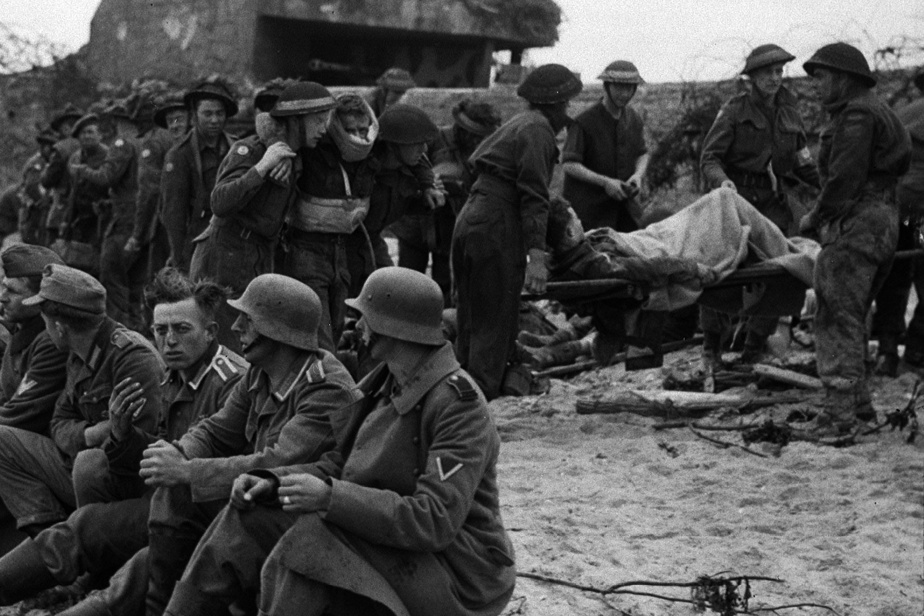The ICI Première show Today the story, is so popular that the publisher Septentrion has grouped various subjects into 13 thematic books. The most recent is inspired by the fifteen contributions, including six devoted to the Second World War, by Professor Stéphane Roussel.
A happy initiative since the title of this opus, The Second World War – Germans and Canadians face to facea reference to episodes of the conflict where Canadian and German soldiers fought hand to hand on European soil.
This title does not mean, however, that the entire book is focused on that. In fact, the first three chapters – well documented and fascinating – focus on the ABCs of the Waffen-SS, the myth of Marshal Rommel and the German Tiger tank which also had weak points despite its aura of invulnerability.
The Canadian-German face-to-face begins in chapter 4. In essence, the author looks at the massacre of 156 Canadian soldiers in the dozen days following the Normandy landings (June 6, 1944), the team of 4000 kilometers from the tank nicknamed “Bomb” (an American Sherman M4A2) of the Fusiliers de Sherbrooke and the liberation of the Netherlands.
But to our great astonishment, and this is the main failing of this work, Mr. Roussel hardly addresses (only two lines!) the terrible shock of the Dieppe raid of August 19, 1942 where 916 Canadian soldiers were killed, including 106 from the Fusiliers Mont-Royal regiment. However, this is the first real face-to-face meeting between the soldiers of the two nations.
And since around 1950 of them were taken prisoner, it was an opportunity to describe how they experienced their captivity. But no, there is nothing.
The author recognizes that a chapter should have been devoted to it. “I started with existing materials and above all I sought to give a little coherence to these notes on disparate episodes,” he wrote to us. Furthermore, this subject has been very well explored by the historian Béatrice Richard [du Collège militaire royal de Saint-Jean], while the 1944-1945 campaign seems to me, in comparison, often neglected. »
In his defense, it should be noted that Mr. Roussel did not present episodes on Dieppe at Today the story.
That said, the book is very good. Its main strength lies in the author’s desire to show us the hidden side of certain historical elements towards which we too often shine the same light.
Mentioned a little above, the massacre of Canadians by young fanaticized German soldiers in Normandy is an example. Their execution explicitly contravened the rules of war (they exist). Worse still, the perpetrators of these abuses were little punished, starting with officer Kurt Meyer who, imprisoned in New Brunswick, would be transferred to a German prison after a few years before living freely the last seven years of his life.
More delightful is the chapter devoted to the formidable German Tiger tank that Mr. Roussel explores in all its facets. He even analyzes the appearances, true and false, of the Tiger in war filmography, including the sympathetic Kelly’s Heroes by Brian G. Hutton, a work which was the scoundrel version of Monuments Men.
Finally, the author does not hesitate to criticize the behavior of Canadian soldiers when necessary. Thus he presents us with a slightly darker version of the liberation of the Netherlands, based here on recent historiography.
In short, Stéphane Roussel was able to approach these subjects with essential nuances.
Extract
“A walk through the streets of the city of Sherbrooke will perhaps take you to William Street, which will lead you to pass in front of the armory of the Sherbrooke Hussars regiment. To the right of the imposing colonnade sits a float, like in front of many other rides across the country. But Bomb, as its crew nicknamed it at the time, has a very particular history that places it in a class of its own. It is in fact one of the very rare Canadian tanks to have participated in the Normandy landings on June 6, 1944 and to have survived the entire campaign for the liberation of North-West Europe…”
Who is Stéphane Roussel?
Holder of a doctorate in political science from the University of Montreal, Stéphane Roussel is a full professor at the National School of Public Administration (ENAP) where he teaches foreign policy and defense policy. He collaborated on around fifteen episodes of the show Today the story broadcast on ICI Première. He regularly grants interviews to the media, including The Press.

The Second World War – Germans and Canadians face to face
North
156 pages
